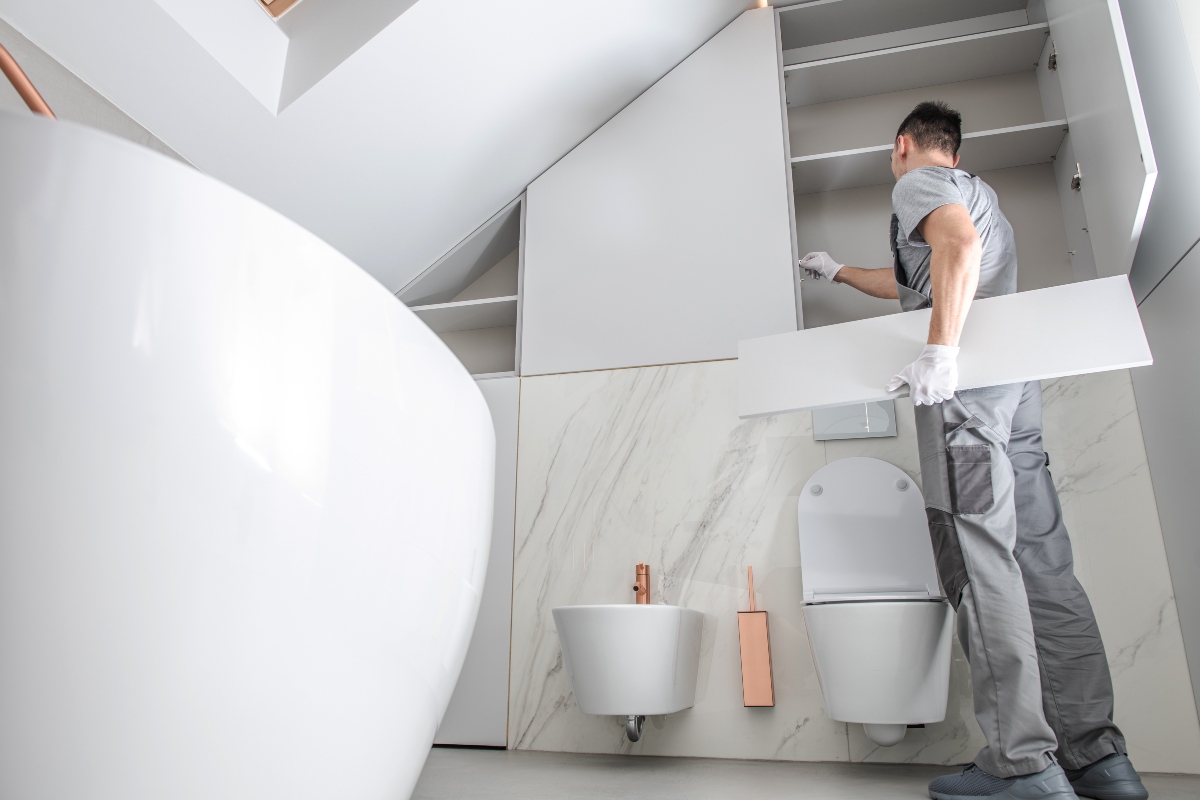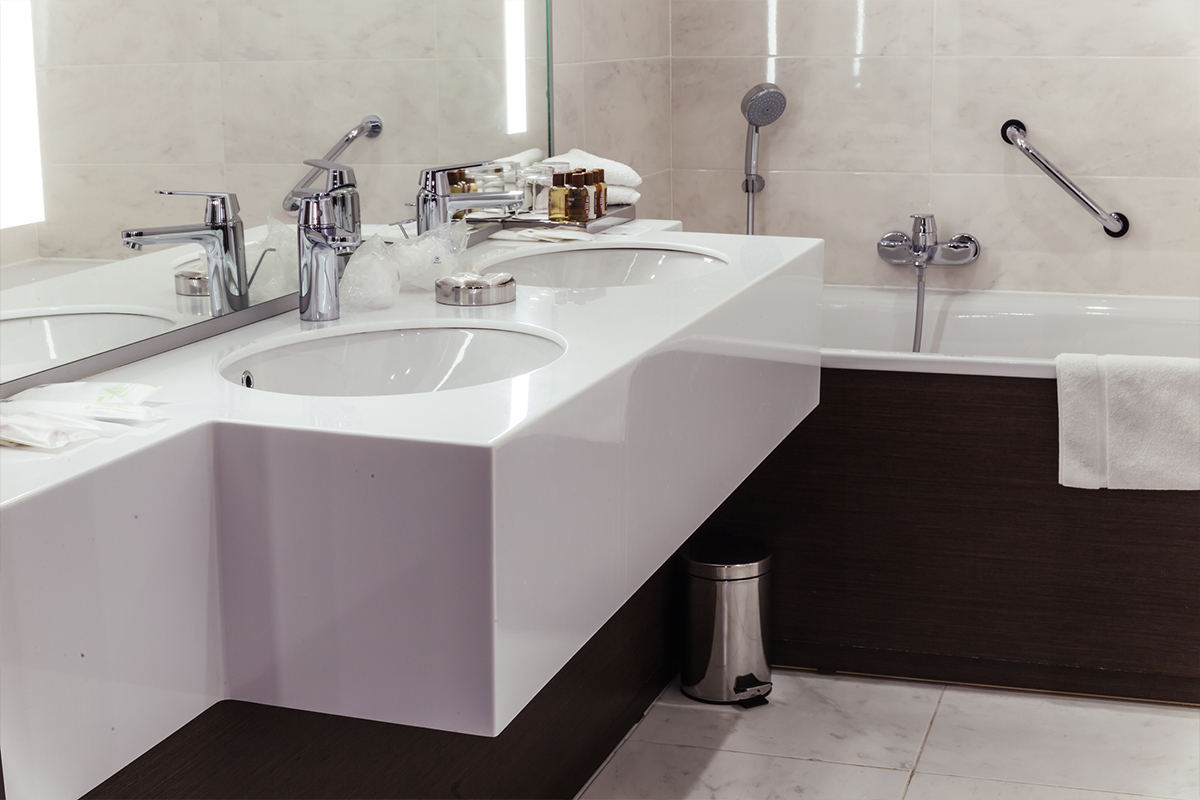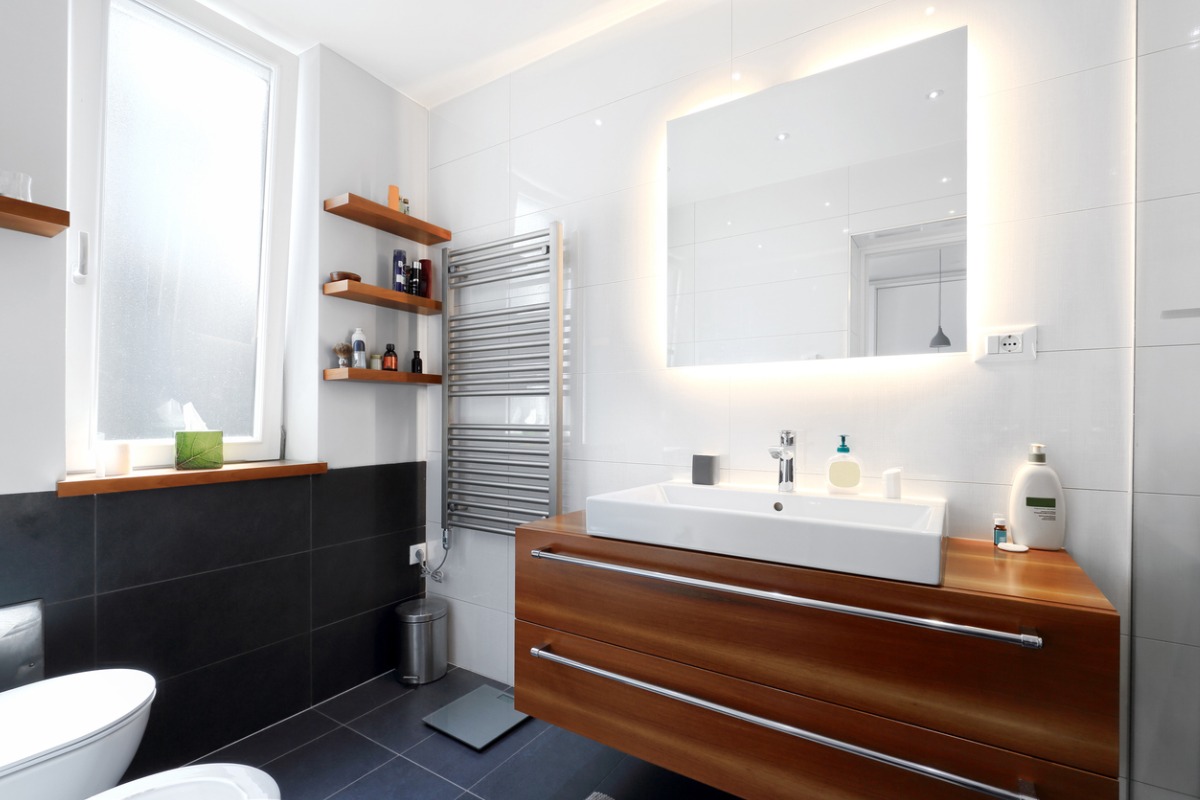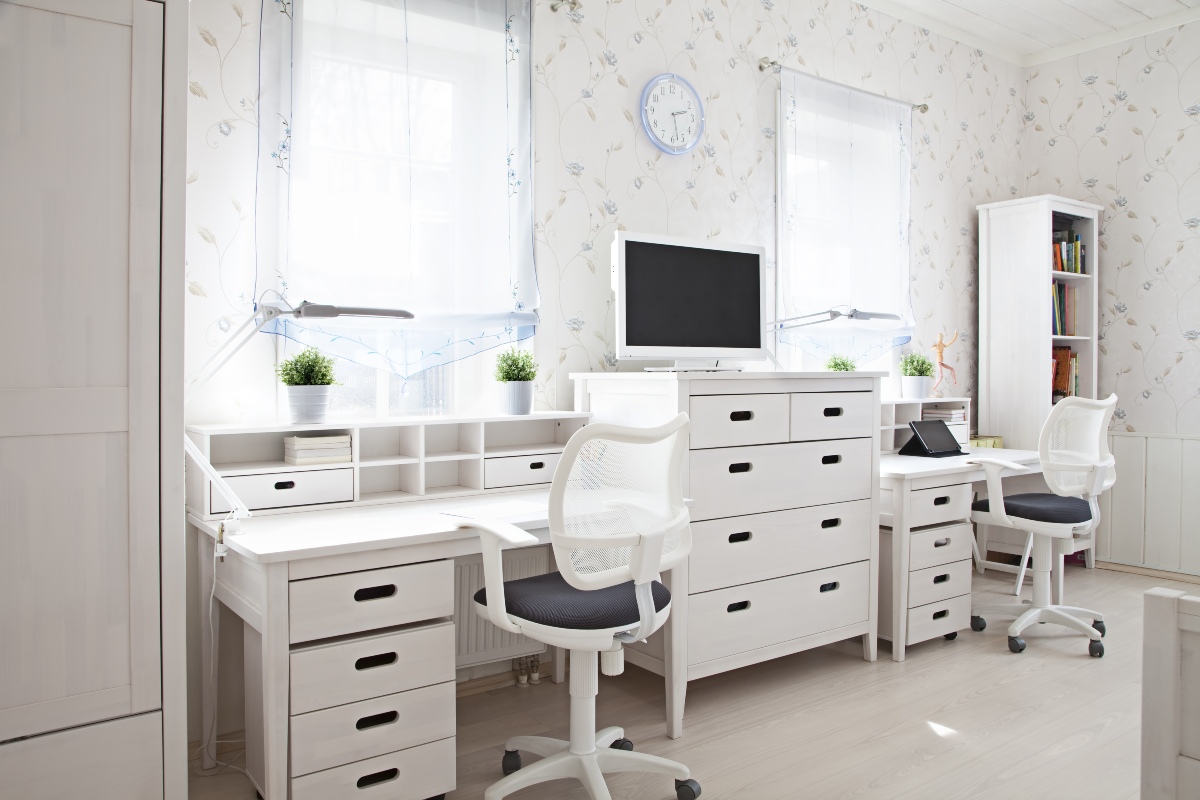A small ensuite bathroom can feel like the best upgrade in the world when it is planned well. It gives you an en suite you can use first thing in the morning, it reduces pressure on the family bathroom, and it can turn a busy day...
Thinking about adding an ensuite bathroom? You’re not alone—more and more homeowners are upgrading their homes with private, connected bathrooms to boost convenience, comfort, and property value. But before you pick out tiles or start knocking through walls, there’s one key question to answer:
Do you need planning permission for an en-suite bathroom?
In most cases, the answer is no; however, there are important exceptions to be aware of. From building regulations to listed properties and flat conversions, this guide breaks down everything you need to consider before getting started. Whether you’re converting part of an existing bedroom or planning a full extension, here’s what you need to know to stay compliant and stress-free.

What is an en suite bathroom?
An en-suite bathroom is a private bathroom that is directly connected to a bedroom, offering exclusive access without needing to walk through shared or communal areas. It’s designed to give you your own space—perfect for comfort, privacy, and convenience.
Popular in master bedrooms and guest suites, en-suites are often associated with a touch of luxury, but they can also be highly practical. Whether you’re working with a generous layout or limited floor space, there are plenty of ensuite bathroom ideas to suit your needs and style.
The design possibilities are flexible, from compact shower rooms with a simple toilet and sink to fully fitted bathrooms featuring a shower enclosure, bath, and sleek vanity unit. Thoughtful planning can also help maximise storage space, making even the smallest ensuite feel organised and efficient.
Whether you're creating a peaceful retreat or adding value to your home, an ensuite offers both comfort and practicality—all in your own private space.
So, do you need planning permission for an en-suite bathroom?
Even if you don’t need planning permission, you will need to meet building regulations when adding an en-suite bathroom. These rules ensure that your new bathroom is safe, structurally sound, and properly fitted, particularly in terms of ventilation, water, and electrical systems.
Whether converting an existing space or creating a new ensuite, building regs approval is a legal requirement in the UK. You can apply through your local authority’s building control department or use an approved private inspector.
However, there are a few important exceptions:
Listed buildings
If your home is a listed building, it is legally protected due to its historical or architectural significance. That protection extends to the interior layout and features, meaning even internal works, such as adding an en-suite bathroom, may require Listed Building Consent—even if no external changes are made.
- You may need both planning permission and Listed Building Consent, depending on the nature of the work.
- This is especially true if plumbing or ventilation changes would impact the historic fabric (e.g., original floors, walls, beams, or windows).
- Always consult your local conservation officer before beginning any work.
Don’t assume internal changes are exempt in listed buildings—get formal approval first.
Flats and maisonettes:
Adding an ensuite in a flat or maisonette can be more complex due to shared structures, party walls, and leasehold restrictions. While internal alterations might not require full planning permission, you may need approval if:
- The work involves structural changes, like moving or altering load-bearing walls.
- You’re altering external features, such as venting pipes, that pass through a shared wall.
- The property has a restrictive lease—you’ll likely need written consent from the freeholder or management company.
Planning permission may be required for structural or external works, and leaseholder approval is typically necessary.
Conservation areas:
If your home is located within a conservation area, there may be additional planning controls in place to preserve the character of the neighbourhood. While internal changes like an ensuite typically don’t require planning permission on their own, you will need permission if:
- You’re making external alterations, such as adding a new window, vent, soil pipe, or flue.
- Your ensuite is part of a larger extension or loft conversion.
Some councils enforce stricter rules in conservation areas—even for minor works—so it’s wise to check with the planning department before making assumptions.
Interior-only works are usually fine, but external changes may trigger permission requirements.
External changes:
Even in a standard property, planning permission is likely required if your ensuite involves modifying the external appearance of your home. This includes:
- Adding new windows or skylights
- Installing visible soil pipes or extractor vents
- Building a new extension to accommodate the ensuite
- Converting a loft or garage (in some cases)
If these changes fall outside permitted development rights—or if your property has already used up its allowance—you may need to submit a full planning application.
Any external alteration that affects how your property looks or functions from the outside could require planning permission.

What if you’re converting an existing space?
Even if you don’t need planning permission, you will need to meet building regulations when adding an en-suite bathroom. These rules ensure your new bathroom is safe, structurally sound, and properly fitted, particularly when it comes to ventilation, water, and electrical systems.
Building regs approval is a legal requirement in the UK, whether converting an existing space or creating a new ensuite. You can apply through your local authority’s building control department or use an approved private inspector.
Your local council or a private building control inspector will assess factors such as:
1) Ventilation
Bathrooms need proper ventilation to prevent damp, mould, and structural damage. If the room doesn’t have an opening window, you’ll need a mechanical extractor fan that vents to the outside. Some local authorities also require fans in addition to windows, especially in small or enclosed en-suites.
2) Drainage and Plumbing
All new pipework must be correctly installed to connect to your home’s existing drainage system. This includes:
- Properly vented soil stacks and waste pipes
- Traps to prevent odours
- Water pressure and temperature control (especially for showers)
Any work involving new connections or changes to your drainage may also need to be signed off.
3) Electrical Safety (Part P)
Part P of the Building Regulations applies because bathrooms are high-risk areas for electric shock. Key requirements include:
- Approved fixtures and fittings with the correct IP (Ingress Protection) rating
- Certified installation by a registered electrician
- Safe placement of lighting, switches, and outlets based on "zones" within the bathroom
4) Structural Integrity
If your ensuite project involves removing or modifying load-bearing walls, adding joists, or cutting into floors/ceilings, you’ll need to demonstrate that the structure remains sound. This usually requires structural calculations and may involve steel supports or reinforcement. You will also need approval if you alter a load-bearing wall or add new joists.

What if you're planning an ensuite as part of a larger project?
If you’re already undertaking a loft conversion, side extension, or any major renovation that requires planning permission, it’s smart to plan your ensuite bathroom as part of that larger project. Including the ensuite in your initial plans and application helps you:
- Coordinate permissions and inspections in one go
- Avoid duplicated paperwork or delays down the line
- Streamline the design for better space planning and plumbing routes
- Ensure compliance with both planning permission and building regulations at the same time
For example, if you’re converting a loft and adding a dormer window to house an ensuite off the primary bedroom, this would typically require planning permission, so including the ensuite in your submission is essential.
Even when planning permission isn't needed, building regulations will still apply. Factoring in the ensuite from the start ensures that your layout, ventilation, and drainage systems meet the necessary standards, helping you avoid costly changes later.
Whether you're designing a stylish toilet for guests, a compact ensuite for a small bathroom, or a full spa-like space in your main suite, planning it alongside larger works is more efficient and cost-effective.
So while most ensuite installations don’t trigger planning permission on their own, it’s always worth checking early, especially if your home is listed, leasehold, or located in a conservation area.

Practical Steps Before You Begin
Before you start knocking down walls or shopping for tiles, it’s important to take a few smart steps to ensure your ensuite project runs smoothly and is compliant with all relevant regulations.
Here’s what to do first:
Hire an Architect or Bathroom Renovation Expert
Consulting a professional can save you time, money, and stress, even for small internal projects. They’ll help you assess the space, plan the layout, ensure compliance with building regs, and coordinate any necessary permissions, especially if your property has quirks like awkward plumbing, structural challenges, or listed status.
Contact Your Local Council or Planning Department
If you're unsure whether you need planning permission or Listed Building Consent, don’t guess. A quick call to your local planning authority can clarify what applies to your property and prevent costly mistakes. Many councils also offer pre-application advice services for more complex builds.
Involve a Building Control Officer Early
Whether you're working through your local council or a private approved inspector, approval of building regulations is required for all new bathrooms. Involving a building control officer early means your designs can be reviewed for compliance before any work begins, reducing the risk of failed inspections or expensive rework later on.
Budget for Inspections and Sign-Offs
While most homeowners plan for fixtures and fittings, many forget to account for regulatory costs. You may need to budget for:
- Building control application fees
- Structural engineer reports (if removing or modifying walls)
- Electrical certification (Part P compliance)
- Drainage inspections
It’s also worth setting aside a small contingency fund for unexpected issues uncovered during the build.

Something to remember...
For most ensuite bathroom additions, planning permission isn’t needed, especially when you're converting an existing space within your home. However, building regulations always apply, and it's essential to meet standards for ventilation, plumbing, electrical safety, and structural integrity.
If your home is listed, in a conservation area, or part of a flat or maisonette, the rules can be more complex, so it’s always worth checking with your local planning authority before starting work.
To ensure your project runs smoothly from start to finish:
- Work with experienced professionals who understand layout and compliance
- Confirm requirements with your local council early in the process
- Plan smartly, whether you’re creating your only bathroom or adding a second space
Design choices also play a significant role in making your ensuite feel both functional and indulgent. Space-saving fixtures like wall-hung toilets, corner toilets and a freestanding vanity unit can maximise floor space and add a touch of modern style. Thoughtful details—from bathroom accessories to lighting—can help transform even a compact ensuite into a peaceful retreat where you can enjoy a relaxing shower at the end of the day.
With the right preparation, your new ensuite can be a valuable, practical, and stylish upgrade—delivered without delays, stress, or legal headaches.
The Conversion Guy - A Professional Bathroom Fitter serving Derbyshire & Staffordshire
Are you ready to take the plunge and transform your bathroom into an oasis? Well, look no further! The Conversion Guy is committed to providing you with a bathroom renovation experience that is unparalleled.
With over 40 years of experience in bathroom remodelling, we are looking forward to helping you create the most amazing bathroom of your dreams! We love talking bathrooms, so be sure to get in touch today or book a free consultation and start your journey towards creating the perfect bathroom retreat!
From the Learning Centre
Explore our resources and learn about pricing, bathroom refits, kitchen kitchen renovations, loft conversions and many other home improvements in our Learning Centre




